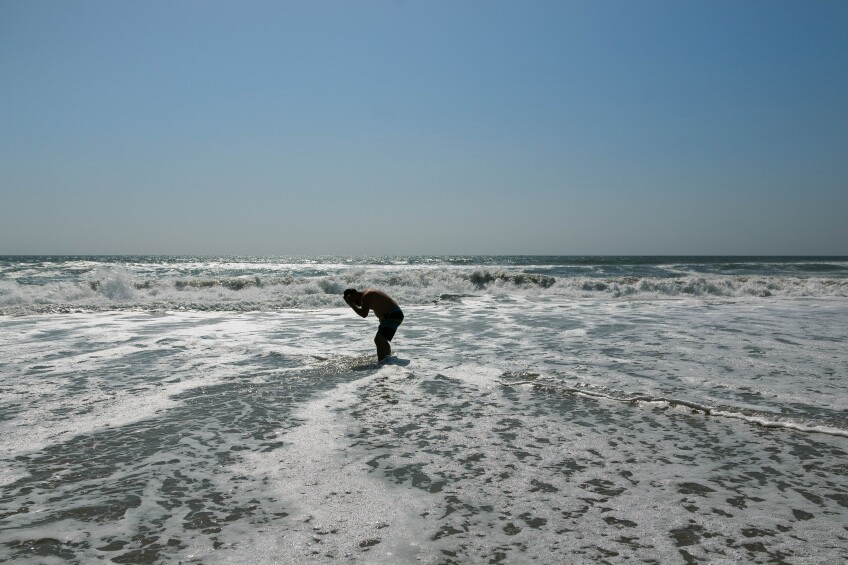Photo Essay: In Oxnard, Latinos by the Beach Create 'A New Reality'

When I first stepped onto Oxnard Shores in northern Oxnard, something felt different. It took me a while, but I gradually realized that, unlike the beaches of Orange County where I grew up, this stretch of sand felt more comfortable to me as a Latina.
Unknown to me at the time, Oxnard and Port Hueneme in Ventura County host a predominantly Latino population, (as well as Samoans and Filipinos, according to a local I later spoke with). It felt like a place where bodies like mine could exist by the water.
"I go to the beach with the family to decompress," said Amadeo, in an earlier interview reporting on farmworkers.
Oxnard's northern beaches are only 15 minutes away from the inner city, and parking was abundant. A different world compared to many Orange County beaches, where a drive could at times take 30 minutes from an inner city like Santa Ana, my hometown.
While Orange County beaches are considered a public space, the overdevelopment in many Orange County cities also meant less access to outsiders.
Scenic places like Corona Del Mar, Laguna Beach or Newport Beach, are riddled with high end restaurants, hotels blocking access or homes that are not affordable to the typical inner city visitor. Parking alone in some of these lots costs up to $4.50 an hour or $15 for a full day in some lots, and that's with limited hours.








Despite the many challenges of getting to the beaches in Orange County, my love for the ocean remained.
Like many Latino families, my mother would pack tortas, hot chips and fresh fruit to last us all day during my childhood summers. It was a free, all-day activity to tire us out; the fun memories were meant to last until the next outing we could afford as a family.
But a new reality set in for me when I moved to what can be considered a small Latino coast.
On Sundays, you can see horses being ridden by coledores or horse trainers on Oxnard Shores while families picnic right across the corner. Many Oxnard residents own cattle and house them in nearby stables, arenas or farms that they rent from. Some are located in Oxnard, or neighboring cities such as Santa Paula or Fillmore.
"It just reminds me of my home, Zacatecas," said Efren, a Oxnard coleador, "it is a memory that I can hold with me and cherish."
Other horse owners take horses to train and take a picnic with them to enjoy the day while soft Spanish melodies play against the crashing waves.



Although million-dollar homes owned mostly by wealthy Oxnard residents line up the Hollywood Beach in north Oxnard, it still feels accessible in a way that Orange County doesn't. Parking is abundant and Oxnard keeps its humble roots with affordable eateries.
This accessibility to the beach is a lifeline to many.
"I come here to decompress during sunset," says Gaby Ibarra, an Oxnard resident.
It was no different for Albert Hernandez, 35, "I come here to pray, relax and take in a natural beauty," Hernandez said as he prepared to jump into the water.





Trouble in Paradise
But Oxnard's coast isn't a pure haven. The 20 miles of Oxnard coastline is also home to two naval bases, a commercial port, three power plants and has a history of toxic dumping.
In contrast to Oxnard Shores and other northern beaches, Ormond Beach in southern Oxnard has struggled with homelessness, crimeand toxic dumping for years. Its issues have made it a focal point for activists like CAUSE, who are trying to inform residents that it is 'ok to visit.' Activists know though that their message is a hard sell for residents who are intimidated by the beach's isolated location between a naval base festooned with stern warnings and a powerplant that is set to be demolished in coming years.


Instead, residents from south Oxnard frequent Port Hueneme, which nestled in between the two sides of the south and north beaches. This small city surrounded by Oxnard holds a commercial port, owned andoperated by the Oxnard Harbor district.
"Port Hueneme is just more culturally relevant to me and Latinos, '' said Hubert Flores,17, as he enjoyed the weekend car show with his girlfriend, Yamila Armenta, 17, who nodded in agreement.




Even with the presence of Port Hueneme, many residents ask why Ormond beach can't be more accessible.


"That power plant technically, is allowed to be there, the agricultural fields, they're allowed to be there. Years and years ago, it was decided, this beach [Ormond Beach], this coast belongs to industry. And, and the other beaches are where families can go and enjoy," said Marquez, making a comparison to beaches like Malibu or Santa Barbara, "and it just doesn't feel like a coincidence that it's like always the same demographics that are like completely cut off, or, you know, bear the burden of pollution or dirty air," said Marquez.

That the Oxnard coast is as welcoming as it is now is because many fought for it including Latinos and farmworkers, according to Lucia Marquez, a Coastal Alliance United for a Sustainable Economy (CAUSE) policy advocate who was present in the 2016 local uprising of residents denouncing the new power plant: Puente Powerplant.
Over time, community groups have gathered around and protested the environmental impacts it has on the majority population: people of color.
Groups like CAUSE have spent years advocating for a more accessible and clean coast.
For one Oxnard resident turned community organizer, their point of migration was clean air.
"I literally came here to breathe clean air," said Odette Moran Lopez, who was born with small lungs because of the pollution in Mexico.
"I come from the outskirts of Mexico city where trash was dumped; it was toxic," said Lopez as they held back tears.
For Lopez, keeping Oxnard a clean and safe place for residents is personal and will keep fighting for a clean and safe coast for Oxnard.
Lopez and Marquez, along with CAUSE, now lead youth in the city of Oxnard to use the beach as a resource and open space.


Oxnard is unique in its identity as a coastal city. Its existence is a chance for Latinos to call a slice of the California coast their own, which is why residents continue to defend and cherish it, hopefully, for many years to come.




